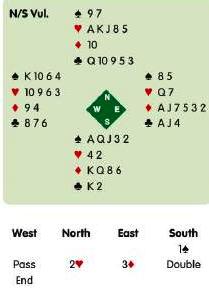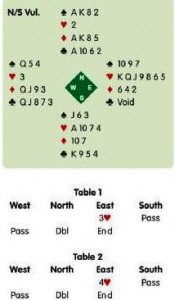Source: Mr Bridge
Rule is a bit of a misnomer. It is a guideline from the 1930 about overcalls and pre-emptive bidding. Paraphrasing the advice – a player cannot afford to be doubled and lose more than 500 unless the opponents have a slam – hence two off doubled vulnerable or three off non-vulnerable. Many deals bid to game at rubber bridge would rest in a part-score at
duplicate. The reason is that each deal stands alone in duplicate. At duplicate, you may need a more conservative
approach – 500 represents more than a non-vulnerable game. At rubber bridge, honours are an added factor.
This was a ridiculous overcall, partly because North’s 2. was forcing. It deservedly ran into a double. After the lead of the four of hearts taken by North’s king, a careful switch to the ten of clubs achieved four down, costing 800. East’s bid was a clear violation of the Rule – he did not have six tricks. If North had simply raised South’s opening bid to 2 ~, the minimum to overcall 3+ would be +A-Q-J-9-x-x and an ace on the side. There is almost a guarantee of six tricks facing a bust. You take this risk to obtain the best lead from partner and perhaps to compete for the part-score. Change the vulnerability to game all and I would pass even on that hand. On my next deal from a teams-of-four duplicate event, East had an ideal hand for opening 3′” with six tricks.
At table 1, South had a difficult decision at his second turn. If he had bid 3NT, even the safe lead of the three of hearts would not have kept him from making nine tricks, scoring 600. North, however, held a near maximum hand for a takeout double. The safer action for South is to pass, but a score of 500 missed the par of 600. At table 2, disregarding the rule,
East opened with 4. and South had no problem in converting the takeout double into one for penalties by passing. The score of 800 was his just reward. In match-paint pairs, 500 and 800 would be the difference between bottom and top scores. The extra 300 could also be significant at teams or rubber.
My final deal is from matchpoint pairs:
At adverse vulnerability, West’s 4~ is far too risky. When the opposing game -if there is one – is worth only 420, you
cannot afford to lose even 500. West’s overcall should have been 1~ – even 3~ would be too much. 4~ doubled went for 1,100 when the opponents took all their tricks. West thought this was very unlucky.
How would South have fared in 4. ? If West takes a top spade and continues with a low one, East can ruff high – the so-called uppercut – to promote West’s ten of hearts. -450 would have given East-West a good matchpoint score.
In summary, you can afford to lose 500 if the opponents can make a vulnerable game, but even 200 is too much if all
they can make is a part-score. Take great care when you are vulnerable.
Esta entrada también está disponible en: Spanish

